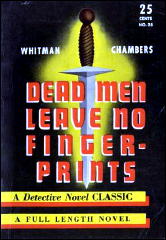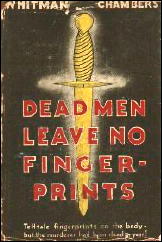Thu 5 Mar 2020
Archived PI Review: WHITMAN CHAMBERS – Dead Men Leave No Fingerprints.
Posted by Steve under Authors , ReviewsNo Comments
NOTE: This review from the past was first posted on this blog on August 11, 2009. I’ve been prompted to reprint it because the previous review, also a repost, was of the movie Murder on the Campus, which was based on another book by Whitman Chambers, also a locked room mystery.
—
WHITMAN CHAMBERS – Dead Men Leave No Fingerprints. Stanton Lake #1 (and only appearance). Doubleday, hardcover, 1935. Hardcover reprint: Caxton House, 1939. Paperback reprint: Detective Novel Classic #28, circa 1943.

Late last year I made a major purchase of over 200 of old mystery digest paperbacks like this, most of them being published in the 1940s. Most of them also are abridged, cut “to speed the story,” and if so they’re not very desirable from a reading standpoint, but the often lurid covers can still make them very much collectible. This one, with no indication otherwise, is the full, uncondensed version.
And it provides a relatively inexpensive way to read a mystery writer about whom I know nothing more than a list of the books he wrote. With no characters ever appearing more than one book, Chambers never made a name for himself the easy way. His first mystery appeared in 1928, and he seemed to hit his stride with nine books from Doubleday (not all under the Crime Club imprint, as I recall) between 1934 and 1941.
A few more novels appeared through the war years, then one paperback original from Pyramid after the war ended, followed by two more paperback originals from the relatively schlocky Monarch line in 1959 and 1960.
I mentioned the lack of a continuing series character. If Chambers would have decided to go with one, you’d think it would have to be the leading player in this book, a private detective named Stanton Lake. Most of the action takes place at a beach hideaway near Dipsea, 16 miles north of San Francisco, as Lake tries to help a beautiful Danish movie star stay out of trouble with the moral-turpitude clause of her contract.
Hilda Haan — that’s her name — had a stand-in leave the country under her name while she went for a quiet sojourn in the country with one Theodore Raybourne. It was intended to be a love nest for two, but now that she wants out, Theodore’s family has moved in, and she needs Lake’s help.
In he goes as well, and soon after, murder follows, in a house with all of the entrances locked from the inside. It was not a fool-proof job of locking, but it is still almost assuredly an inside job.

The biggest obstacle to cracking the case is not the locked room aspect, however. It’s the fact that the only fingerprints on the murder weapon are those of a dead man, a convict who died in prison without ever being released.
A second murder is even more puzzling, occurring in a totally sealed room. An immediate solution presents itself, but to add to the growing bewilderment, it also does not hold up to close inspection. Chambers had fun with this one, I think, even though this is not a major entry in the list of Locked Room Mysteries:
Here’s a quote to show you what I mean about the fun part. From page 89:
“I was,” the sheriff admitted, “thinkin’ something like that.”
“Let it pass,” Lake advised. “Keep your mind open until all the evidence is in. It is not impossible that John Royal killed [..] and that Pageot killed [..], however incredible it appears on the surface. Just remember that we are still on the surface. We may have a long way to go before we are on the bottom, and” — he smiled calmly — “we may already be there and don’t know it….”
While the murder method may be a bit far-fetched (and Chambers makes it sound as though it just might work, maybe), the motive(s) is/are — well, let’s just say “interesting” is the key word, without saying how likely it (or they) may be.
I apologize for deliberately trying to be vague here. Lake sweats this one out, doggedly serving his client’s interests all the way through, and being rewarded mightily in the end for his efforts.
Is this one worth reprinting? It’s a minor find, not a major one, pulpishly told, a little bit goofy, in all honesty, and flawed no doubt by investigative practices no longer found acceptable today (page 91) and by the stereotypical representation of a Chinese servant who not so incidentally has an important role to play in the tale.
Is it worth reading, though? Assuming that you’ve read (and understood and/or let pass by) all of the qualifying statements made in the preceding paragraph, a definite “yes” to this one.